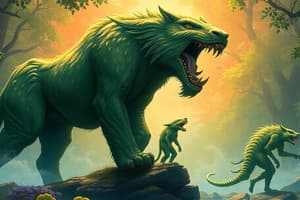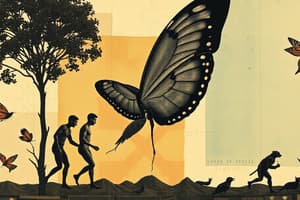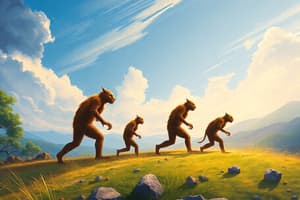Podcast
Questions and Answers
In a population of birds, males with brighter plumage are more attractive to females, leading to these males having more offspring. This is an example of which type of selection?
In a population of birds, males with brighter plumage are more attractive to females, leading to these males having more offspring. This is an example of which type of selection?
- Intrasexual selection
- Directional selection
- Intersexual selection (correct)
- Stabilizing selection
Which condition would LEAST likely lead to a change in allele frequencies in a population?
Which condition would LEAST likely lead to a change in allele frequencies in a population?
- Non-random mating based on preferred traits.
- A small group of individuals becoming geographically isolated from the main population.
- An infinitely large population with random mating and no selection. (correct)
- The introduction of a new, highly advantageous allele.
A population of fish lives in a lake. Due to pollution, the average water depth decreases, and larger fish are now more easily preyed upon. Over time, the population shifts towards smaller body sizes. What type of selection does this demonstrate?
A population of fish lives in a lake. Due to pollution, the average water depth decreases, and larger fish are now more easily preyed upon. Over time, the population shifts towards smaller body sizes. What type of selection does this demonstrate?
- Directional selection (correct)
- Artificial selection
- Disruptive selection
- Stabilizing selection
Which of the following is an example of intrasexual selection?
Which of the following is an example of intrasexual selection?
A population of birds is split into two by a large river. Over time, the two populations evolve into distinct species due to the geographical barrier. This is an example of:
A population of birds is split into two by a large river. Over time, the two populations evolve into distinct species due to the geographical barrier. This is an example of:
Which of the following best illustrates the concept of artificial selection?
Which of the following best illustrates the concept of artificial selection?
A hurricane drastically reduces the size of a bird population on an island. By chance, some alleles are lost, and others become overrepresented in the surviving population. This is an example of:
A hurricane drastically reduces the size of a bird population on an island. By chance, some alleles are lost, and others become overrepresented in the surviving population. This is an example of:
Which of the following describes stabilizing selection?
Which of the following describes stabilizing selection?
Which of the following is an example of a vestigial structure?
Which of the following is an example of a vestigial structure?
Which of the following conditions is required for a population to be in Hardy-Weinberg equilibrium?
Which of the following conditions is required for a population to be in Hardy-Weinberg equilibrium?
The independent evolution of similar features in different lineages is known as:
The independent evolution of similar features in different lineages is known as:
What is the role of mutation in evolution?
What is the role of mutation in evolution?
Why is the RNA world hypothesis a plausible explanation for the origin of life?
Why is the RNA world hypothesis a plausible explanation for the origin of life?
Which of the following is an example of a prezygotic barrier to reproduction?
Which of the following is an example of a prezygotic barrier to reproduction?
What is the significance of unsaturated fatty acids in maintaining membrane fluidity in cold environments?
What is the significance of unsaturated fatty acids in maintaining membrane fluidity in cold environments?
Which of the following statements accurately describes the relationship between natural selection and phenotypes?
Which of the following statements accurately describes the relationship between natural selection and phenotypes?
Which of the following scenarios best describes the 'founder effect'?
Which of the following scenarios best describes the 'founder effect'?
Homologous structures provide evidence for evolution because they demonstrate:
Homologous structures provide evidence for evolution because they demonstrate:
What is the most likely outcome for a small, isolated population that experiences a loss of genetic diversity?
What is the most likely outcome for a small, isolated population that experiences a loss of genetic diversity?
Humans contribute to the decline in global biodiversity primarily through which of these actions?
Humans contribute to the decline in global biodiversity primarily through which of these actions?
Flashcards
Artificial Selection
Artificial Selection
Selective breeding to encourage desirable traits over generations.
Natural Selection
Natural Selection
A mechanism of evolution where advantageous traits increase survival and reproduction, passing genes to the next generation.
Intersexual Selection
Intersexual Selection
Selection where one sex chooses mates of the other sex, leading to traits like colorful plumage in males.
Intrasexual Selection
Intrasexual Selection
Signup and view all the flashcards
Directional Selection
Directional Selection
Signup and view all the flashcards
Stabilizing Selection
Stabilizing Selection
Signup and view all the flashcards
Disruptive Selection
Disruptive Selection
Signup and view all the flashcards
Genetic Drift
Genetic Drift
Signup and view all the flashcards
Bottleneck Effect
Bottleneck Effect
Signup and view all the flashcards
Founder Effect
Founder Effect
Signup and view all the flashcards
Gene Flow
Gene Flow
Signup and view all the flashcards
Homologous Structures
Homologous Structures
Signup and view all the flashcards
Adaptive Radiation
Adaptive Radiation
Signup and view all the flashcards
Convergent Evolution
Convergent Evolution
Signup and view all the flashcards
Analogous Structures
Analogous Structures
Signup and view all the flashcards
Behavioral Isolation
Behavioral Isolation
Signup and view all the flashcards
Temporal Isolation
Temporal Isolation
Signup and view all the flashcards
Mechanical Isolation
Mechanical Isolation
Signup and view all the flashcards
Habitat Isolation
Habitat Isolation
Signup and view all the flashcards
Gametic Isolation
Gametic Isolation
Signup and view all the flashcards
Study Notes
Artificial Selection
- Artificial selection is selective breeding, encouraging desirable traits across generations.
Natural Selection
- Natural selection drives evolution, favoring traits that enhance survival and reproduction; these traits are then passed down.
- Natural selection relies on two key observations:
- Traits are inherited from parent to offspring.
- More offspring are born than can survive, leading to competition and differential survival.
- Traits aiding survival accumulate in populations, driving evolution.
- Nature favors traits for survival and reproduction, while artificial selection involves humans choosing desired traits.
- Intersexual selection involves mate choice by one sex, often leading to colorful males and selective females.
- Intrasexual selection involves competition among males for dominance and control over females or breeding territories.
Phenotype Distribution and Selection
- Directional selection favors one extreme phenotype.
- Stabilizing selection favors average phenotypes, reducing extremes.
- Disruptive selection favors both extremes, potentially splitting the population.
Evolutionary Fitness
- Evolutionary fitness is measured by the number of offspring that survive.
Hardy-Weinberg Equations
- p + q = 1: The sum of the frequencies of the dominant allele (p) and the recessive allele (q) for a gene with two alleles equals 1.
- p² + 2pq + q² = 1: This equation describes the genetic makeup of a population, including homozygous dominants (p²), heterozygotes (2pq), and homozygous recessives (q²).
Allele Frequency Consistency
- Allele frequencies remain constant if these conditions are met:
- Infinitely large population
- No natural selection
- Random mating
- No gene flow
- No mutations
- Meeting these conditions means the population is not evolving.
Genetic Drift
- Genetic drift is a random change in allele frequencies, especially prominent in small populations.
- Bottleneck effect: A large population reduction due to a non-selective disaster can lead to over or underrepresentation of alleles.
- Founder effect: A small, isolated group establishes a new population with a different gene pool.
Gene Flow
- Gene flow is the movement of alleles between populations.
- Gene flow can alter allele frequencies and reduce genetic differences between populations.
Homologous Structures
- Homologous structures are similar characteristics in different species due to shared ancestry.
- Example: Arm bones across various species.
Adaptive Radiation
- Adaptive radiation occurs when one species evolves into multiple descendant species with unique adaptations.
Evidence for Evolution
- Fossil Record: Reveals changes in organisms over time, using the law of superposition and absolute dating of radioactive isotopes.
- Comparative morphology analyzes the structure of living and extinct organisms.
- Homology: Similar characteristics in related species, despite functional differences.
- Embryonic homology: Similar embryonic development across species.
- Vestigial structures: Conserved structures with no current function.
- Molecular homology: Shared ancestry indicated by molecular structure and monomer sequence.
- Convergent evolution: Distantly related organisms evolve similar adaptations because of comparable environments
- Analogous structures: Similar structures with separate evolutionary origins, like wings in birds, bats, and bees.
- Biogeography: The geographic distribution of species. Species on oceanic islands often resemble mainland species.
- Homologous traits: Traits sharing a common underlying structure and embryological origin reflect descent with modification from a common ancestor.
Pseudogenes
- Pseudogenes are nonfunctional gene variants providing evidence for evolution.
Eukaryotic Origins
- Features indicating a single origin for all eukaryotes:
- Nucleus
- Mitochondria
- Endomembrane system
- Genes with introns
- Linear chromosomes
- Sexual reproduction with gamete fusion
Species Definition
- A species can naturally breed and produce fertile offspring and is reproductively isolated from other groups.
- This definition is not absolute; closely related species may produce hybrids.
Isolating Mechanisms
- Isolating mechanisms maintain separate gene pools between species.
Prezygotic Barriers
- Prezygotic barriers prevent mating or fertilization:
- Behavioral isolation: Unique behaviors separate species.
- Temporal isolation: Species breed at different times.
- Mechanical isolation: Reproductive anatomy is incompatible.
- Habitat isolation: Species live in different habitats.
- Gametic isolation: Gamete incompatibility prevents fusion.
Postzygotic Barriers
- Postzygotic barriers prevent viable, fertile offspring:
- Hybrid viability: Incompatible genes impair development.
- Hybrid fertility: Hybrids cannot reproduce.
- Hybrid breakdown: Later-generation hybrids are infertile.
Speciation Models
- Allopatric speciation occurs when a geographic barrier separates a species, leading to genetic divergence and reproductive isolation.
- Sympatric speciation occurs without a geographic barrier, potentially through polyploidy in plants, or adaptations to specific microhabitats in animals.
Adaptive Radiation
- Adaptive radiation involves one species giving rise to multiple descendant species with unique adaptations.
- Phylogeny reflects adaptive radiation, homologous traits, and vestigial traits.
- Natural selection acts on phenotypes; advantageous traits increase survival and reproduction.
- Variation is essential for natural selection and adaptation.
Maintaining Membrane Fluidity
- Variations in phospholipid structure, like unsaturated fatty acids, maintain membrane fluidity in cold conditions.
Extinction Process
- The process leading to extinction involves:
- Small, isolated population
- Genetic drift and inbreeding
- Loss of genetic diversity
- Reduced fitness and adaptability
- Less reproduction and higher mortality
- Smaller population, restarting the cycle
Biodiversity Decline
- Humans contribute to declining biodiversity through habitat destruction, overhunting, and introducing invasive species.
Phylogeny
- Phylogeny represents evolutionary history.
- A clade is a group of organisms with a common ancestor.
- A node is where lineages diverge, representing a common ancestor.
- Sister groups are lineages that split from the same node.
- Outgroups are distantly related to determine evolutionary relationships.
Phylogenetic Groups
- Monophyletic group: Includes a common ancestor and all descendants (clade).
- Paraphyletic group: Includes a common ancestor but not all descendants.
- Polyphyletic group: Excludes the most recent common ancestor of all members.
- Sister taxa share an immediate common ancestor and branch from the same node.
- A basal taxon diverged early and remains relatively unchanged.
Origin of Life
- Earth formed around 4.6 billion years ago; life appeared by 3.9 billion years ago.
- Early Earth had inorganic molecules.
- Oparin and Haldane: The early atmosphere contained hydrogen, methane, ammonia, and water which led to the formation of organic molecules.
- Miller and Urey simulated early Earth conditions and produced organic compounds, including amino acids.
- RNA World Hypothesis: RNA was the earliest genetic material because of its catalytic and information storage capabilities.
Evolutionary Concepts
- Mutation is the source of new alleles.
- Evolution is driven by mutation, selection, drift, and gene flow.
- Gene flow can alter fitness.
- Microevolution: Small genetic changes within a population over time.
- Macroevolution: Large-scale patterns, like speciation and extinction.
Studying That Suits You
Use AI to generate personalized quizzes and flashcards to suit your learning preferences.




